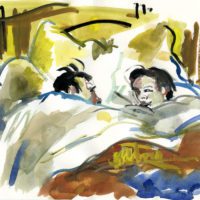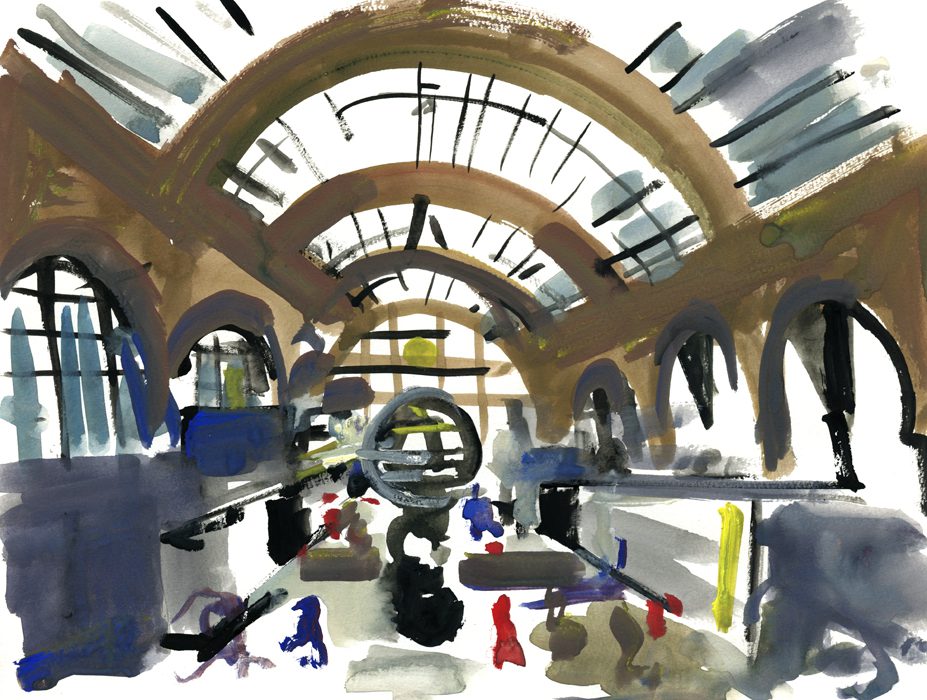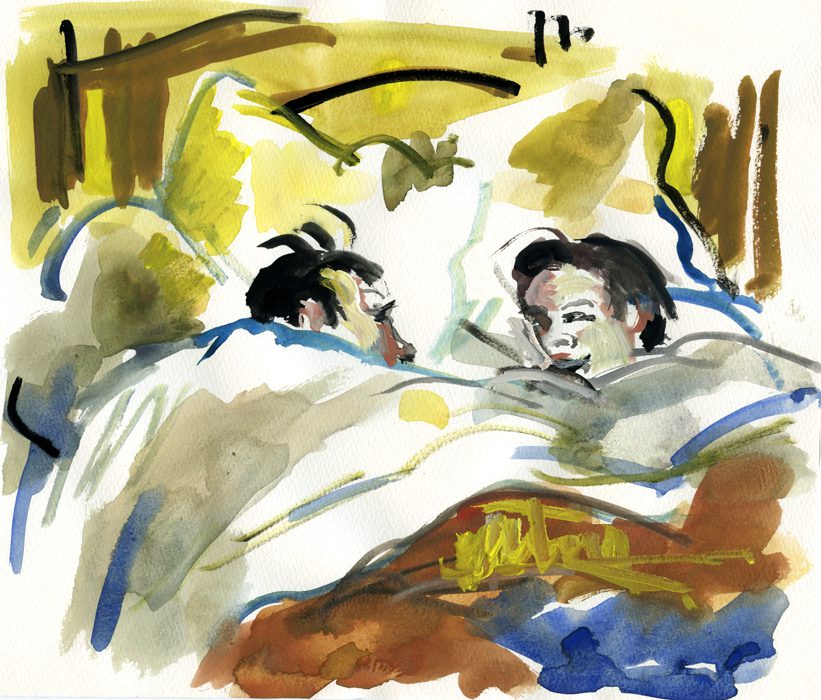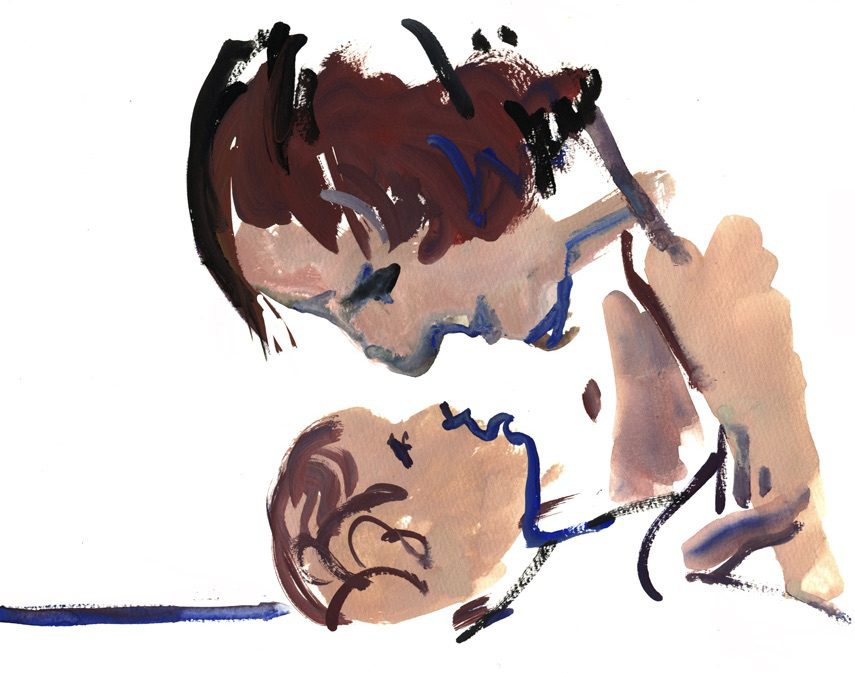I stood transfixed and I stared at the two faces in the painting. Covers up to the chin, tousled brown hair, turned toward one another, closeness reflected in the bloom of their cheeks. I wondered if the glow came from inside the room or perhaps through a window, or maybe from their cheeks, themselves. I couldn’t ascertain if the faces belonged to men or women or children, but it didn’t matter. As the footsteps on the old wooden parquet floors echoed all around me, I stood for a long time and studied the light, the tilt of their heads, the way their bodies lay hidden beneath a mountain of sheets and a red bedspread. A feeling that bounced between longing and panic rolled through my chest and lodged in my throat. I was fixed, overwhelmed by something I couldn’t have, until I tore myself away and ran toward the stairs. Outside of the Musée d’Orsay, I tried to catch my breath, to stop the tears.
I lit a cigarette and sat on the wide steps, as tourists spoke too many languages and stepped around me in their rush to see more. The afternoon sun made the Seine glow, and I shut my eyes and took a long drag. After a while, I went back inside to browse the museum book store and found myself in front of the painting again, this time on a postcard, which I bought. I held the slim paper bag against my chest. It wasn’t the first time; I’d bought the same postcard months earlier on my first trip to Paris, before I blew up my life and left my boyfriend and friends and family and career to head to a city where maybe I could remember how to love. Isn’t that why people traveled to Paris? To learn how to love, learn how to keep one’s heart open when someone said, “I love you.”
My boyfriend of six months said, “I love you.”
I said, “I want an open relationship.”
The movie star I cheated on my boyfriend with, he said, “I love you, Erin.”
I said, “You don’t even know me. I have to go.”
And I wanted to say, I love you, too. I wanted to let him hold me and stop me from ricocheting between him and my boyfriend and the French skater I met on a music video set and the skater’s twin brother and my scene partner from acting class and the comedian and another scene partner and the guy I worked with who sent me flowers and told me he loved me, too.
I wanted to stop withholding from them, but withholding was like a drug. Withholding made me feel like I was in control. That’s what I was always looking for from drugs—a way to control, suppress, manipulate my feelings, my memory, my heart. And, like any other drug, I couldn’t get enough.
I left the museum in the golden hour; it was one of the last long days of early autumn in Paris, before the light gets low. It was dusk by the time I got back to my apartment in the southwest corner of the city. My apartment was dark.
“Hello?”
No one replied; my roommate wasn’t home. The wide planks of the floor moaned beneath my feet instead.
I taped the postcard on the wall next to my bed—just the way I had it in LA when I returned from Paris the first time—and lay down in front of it and that feeling of longing and loneliness began to tilt and spin inside me again. I had an overwhelming desire to be there, in that bed, the one on the wall. Instead I was alone in mine. I turned over and fumbled to push play on whatever CD was in my boom box and Ian Curtis sang “she’s lost control, again.” Maybe everything I did was running from that one line. And yet, inevitably, my need to control put me out of control.
I was alone in Paris for a while. Then I met him.
We met on my twenty-second birthday and I was drunk and had taken Vicodin and felt fuzzy so he never quite came into focus. He came into focus two months later. And when he did, he kissed me and I got lost in his lips. And later when he did, he told me he had a girlfriend he loved. And later when he did, he said he couldn’t stop himself. And later when he did, I couldn’t stop myself. And later when he did, we danced through bliss and shame—we had sex on the hard, creaking floor in the hallway; ate fruit with mint and creme fraiche and chestnut cream; he held my naked body until he lit a cigarette, pushed me away, and said he was confused again, again, again—and it broke me in an entirely new way.
And still, I laid in bed and stared at the postcard and wondered if that was us. I wondered why there was something missing, why I couldn’t have it.
Le Lit—“The Bed”—was painted by Henri de Toulouse-Lautrec around 1892. It measures 21.1 inches x 27.6 inches, oil paints on cardboard and mounted on wood. It is from a group of four paintings, all of which feature women in bed together, lesbians, sex workers.
At the time this was painted, Toulouse-Lautrec spent his days in maisons closes—official brothels—in Paris. They were outsiders, those women, which must have appealed to Toulouse-Lautrec, an outsider in his own right. Maybe that’s what resonated with me.
What I love is that the paintings don’t feel like an exploitation of sex workers, but a humanization. He captured small moments, human moments, intimacy. True intimacy. Emotional intimacy. I saw it in the slight smile, the bloom of the cheek, how utterly relaxed their heads are on the pillows, how they could face each other and just be still. It’s what I longed for in the minutes and hours I stared at that painting, both at the Musée d’Orsay and next to my bed. I knew how to be naked. I knew how to offer my body and fuse it with someone else’s. I knew how to access corporeal sensations.
I didn’t know how to face someone, head to head, in the glow of light, from the room or from our cheeks.
From an early age, I learned how to hide even though it didn’t look like hiding; I liked to be social and spend time with friends and lovers. But I spent this time hiding the parts of me I couldn’t accept, the parts I didn’t want anyone to see, the parts I pretended didn’t exist. I hid my drug use. I hid my cheating. I hid my spending habits. I hid who I was seeing and where I was going. I hid this from my family, from my boyfriends, from my lovers, from my friends, from the people who thought they knew me the best.
Intimacy is a process. Intimacy doesn’t happen because you lie next to someone, in someone, on someone, naked. Intimacy is built over time, when you’re willing to stay. Intimacy is looking and being seen in return. It takes two participants. Emotional intimacy is closeness built on openness and sharing emotions and, most importantly, trust.
I don’t trust you, I thought when they told me they loved me. But really, I didn’t trust me.
“I love you.”
“But you don’t even know me.”
How could he, how could they? I never let them know me, did I? Or did he—did they—know me despite my best efforts to hide? Instead of running toward the people I loved, I ran myself into the walls I’d built around myself. Again. And again.
After Paris, after him, there would be more love, or more potential for love. I continued to do what I knew how to do. I played emotional chicken. I’d get close; I’d play the role of daughter or friend or lover or girlfriend. And just when the parts I hid were about to collide with the people I loved, I’d push. Push, push, push, until one of us fell away.
All of that pushing is painful. I pushed with nasty words; I pushed with silence. I pushed with infidelity and lies. I pushed with disappearing and leaving my body right there. I lay in my bed in Beachwood Canyon, I lay in my bed in the condo near Runyon Canyon, I lay in my bed in Echo Park, in my treehouse, and stared at the heads in the painting, their tousled brown hair, their covers up to the chin. I burned with wanting that and I burned with believing I couldn’t have it. I burned with being unsure of what it even was, of how it would feel.
I lay in those beds with boyfriends and lovers and heroin. I lay in those beds trying to smother that longing with as much heroin and as many lovers as I could. I lay in those beds and swore I didn’t want, that I controlled the limits of my desire despite the burning in my chest.
And then there was Atticus.
I was twenty-eight when I got pregnant. It wasn’t the first time. The first time I was twenty-six and I had an abortion in the midst of smoking heroin and crack and trying to carve my life away into nothing.
Faced with the same decision again, I thought I probably shouldn’t have the baby. I was strung out, again. I couldn’t stop, again. But I decided to have that baby. I found a way to stop using drugs, even though I didn’t believe I would stay stopped. I didn’t believe I’d escape the loop of cycling through relapse after relapse. I didn’t believe in the possibility of a life that didn’t end in me destroying myself
Pregnant and miserable, an ocean away from Paris and in bed with a man I didn’t want, I tucked Le Lit under my pillow. The back was peeling where I’d put so many pieces of scotch tape and pulled them off as I moved my body to another bed, the postcard to another wall. In the dark, I would pull it out and feel the sticky parts, the small rough strips of paper pulling away, running away. How will I be a mother when all I know is being alone?
Atticus was born on a hot night in August, the busiest day of that year for the hospital. The ambivalence I’d felt during my pregnancy quickly dissipated when the nurse put him on my chest and we looked into each other’s eyes.
Oh, it’s you.
And then, I love you more than I hate myself.
I don’t know if that happens for every parent, the button pushed, the one that melts away the icy armor you’ve spent years collecting. It did for me. That I could love him, that I could allow my heart to splay open and risk being destroyed by loving someone so much, made me welcome intimacy for the very first time.
In the months after his birth, as my marriage disintegrated and I was learning to live, learning to love, learning to take care of another human and myself, I kept Le Lit in my nightstand.
One morning, when Atticus was about a year old, I opened my eyes. My nose practically touched his tiny nose as we lay there face to face, covers up to our chins. Two tousled heads of brown hair, a glow that came from our cheeks or the sun seeping through the window. I won’t leave.
And later, and later, after more years of learning to live without drugs, learning to live without leaving everyone behind me. And love, learning to love and to accept love. Later, I lay in bed with my husband, the father of my second child, face to face, and I didn’t run. Maybe that’s what I’d longed for all along, undoing the years of holding so tightly to control at the expense of everything else, even the things I desperately wanted. Maybe it was about learning to stay.
I still have Le Lit. I have a few. And I am still transfixed when I hold that postcard in my hands. I am still transfixed thinking about the desire this image excavated, how desperately I wanted it, and what it meant for me when it couldn’t have been further away from me. I am still transfixed when I visit Paris and make my way through the hallways of the Musée d’Orsay, my footsteps echoing on the old wooden parquet floors—never quite sure of where the painting is, but letting my body guide me to my beacon. And sometimes a feeling begins to bounce around inside me and lodge in my throat.
But it’s not longing.
It’s reflection.
***
Rumpus original art by Dmitry Samarov.







